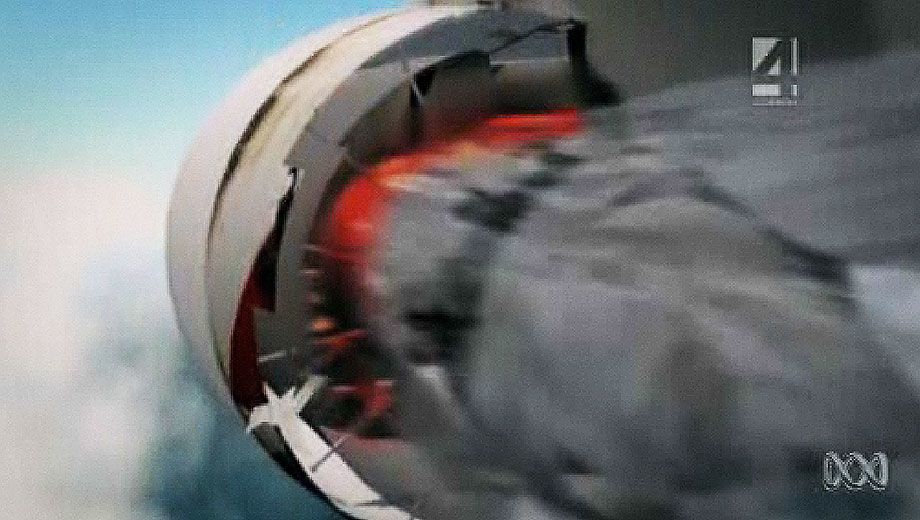UPDATE 30th March: Qantas has today announced it will cut routes, ground planes and raise ticket prices, partly in response to the A380 engine explosion crisis.
ABC TV's Four Corners program revealed last night that Rolls-Royce knew that the engines involved in Qantas' mid-air A380 emergency last November were defective.
The engine maker knew the pipes in the area of the one that cracked were defective, and had already started replacing the whole section of the engine in many of its Trent 900 engines.
However, the engine pipe in Qantas' number two engine on the VH-OGA "Nancy-Bird Walton" A380, had not yet been replaced.
The fault in the pipe was due to a poor modification of an original design, Four Corners reported.
At some point during the design of the engine, Rolls-Royce had decided to put an oil filter onto the pipe, and it had drilled into the pipe to make room for the filter.
However, the technician who had done it hadn't drilled straight, causing part of the tunnel wall to be thinner than it should have been.
This thin part of the pipe wall cracked under the strain of repeated full-thrust take-offs, releasing oil into the engine and creating an engine fire.
Qantas uses full-thrust at take-off due to the heavier fuel weight it has to carry on its A380s to make the trip from Los Angeles to Australian in one leg. Although in this case the plane was taking off from Singapore, the VH-OGA Nancy-Bird Walton A380 had done many Sydney-Los Angeles runs using full thrust takeoffs, which weakened the defective pipe.
The engine fire softened the metal of a retaining arm and caused a turbine disc in the engine to spin out of control and eventually break apart, tearing through the engine cowling and punching a hole in the wing and fuel tanks of the plane.
The debris also severed many control wires in the wing, causing the plane to report more than 58 discrete system failures, each requiring the pilots to respond with a corrective action.
In all, three of the four engines on the plane were affected -- one was completely destroyed, and two were not operating normally, according to the Four Corners report.
The A380 flight computer also reported that it was not possible to land the plane -- with all the system failures at once, the computer was unable to see any way the plane could land.
The crew fudged the data being fed into the computer, painting a slightly less dire picture, and the computer reported back a landing plan that would use 3.9KM of Singapore Airport's 4 km runway.
The pilot made a 'coded announcement' over the PA system, instructing cabin crew to prepare passengers to brace when landing. Four Corners did not reveal the words used in the coded message.
Meanwhile, the plane's satellite communications with Qantas head office had also been cut -- the only communication the plane had was VHF radio communications with Air Traffic Control in Singapore.
On the ground, Qantas' share price was crashing, due to false Tweets claiming a Qantas plane had crashed (based on visuals coming out of Indonesia of pieces of the engine with Qantas branding falling from the sky). These reports were quickly picked up by major news organisations like Fox News and Reuters with apparently no fact checking, with headlines flashing around the world that a Qantas A380 had crashed.
Qantas was caught unaware, with no strategy in place to respond to Tweets. The airline has since opened a Twitter account to respond to customers, as well as a Qantas Media Twitter account to deal with press.
An overwhelming message from the story was the condemnation from Qantas of Rolls-Royce's strategy of making no comment throughout the whole crisis. Qantas CEO Alan Joyce said Rolls-Royce was convinced that BP had dug a hole for itself during its recent oil spill disaster by interacting with the press.
Joyce said Qantas believed BP's mistake was giving out wrong information, and that a strategy of giving true information at regular intervals could only help mitigate the situation.
Some Twitterers during the broadcast of the program last night wondered aloud whether Qantas had approached Four Corners with the story opportunity, given the unprecedented access to the entire flight crew, the Qantas CEO, and even filmed recreations inside the aircraft.
"Would be fascinated to know if Qantas approached #4Corners or vice versa," tweeted ABC Federal Political Journalist Naomi Woodley.
Adrian Young, a Sales Director from Perth, tweeted "Incredible retelling of the Qantas A380 incident on #4corners. Flight crew emerge as heroes. Great PR result for Qantas. Rolls-Royce = booo!"
Even viewers who were already well-informed on the story and didn't find much new in the report agreed with this precis of the story. User iBleeter wrote: "40mins for 'Looks like Rolls-Royce bored a pipe wrong. Also, their PR sucks'. Well produced, though."


18 Mar 2011
Total posts 6
It all comes down to aerodynamics...
https://www.thrombyair.com/2011/01/thromby-aerodynamics/
07 Jan 2012
Total posts 1
what nobody dares to say is that the incident was due to Quantas' negligence. That's why suddenly Quantas became silent and no other airline which used the A380 changed the engines or kept the fleet grounded because they knew what mistake Quantas had made (which they themselves avoided).
Rolls Royce had limited the trust of the engines to a maximum which was below 100% due to technical difficulties. This bulletin was circulated to all airlines but Quantas failed to inform their pilots. So they happily took off with full thrust due to their heavy load (lots of fuel weight due to Australia's remote location). As they were operating the engine beyond its technical specification it was only a matter of time from an incident to happen.
Qantas - Qantas Frequent Flyer
20 Nov 2011
Total posts 186
Wow you are so wrong.....All the airlines operating trent 900 engines had changes made to them following this incident....SQ and EK both grounded A380s at the time of the disaster. As for the thrust issues, the Trent 900 engine was designed for the thrust requirements of QFs pacific routes, and short of design change after the initiall design process the engines are capable of it.....if you actually took the time to read the reports you would know this.....oh and learn how to spell QANTAS.....
22 Dec 2013
Total posts 2
It's VH-OQA (Not VH-OGA). OGA is a Qantas B767-300.
Hi Guest, join in the discussion on Rolls-Royce knew A380 engines were faulty: ABC TV